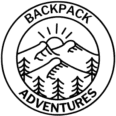This is the compressed version of my 3 week New Zealand North Island road-trip itinerary. If you have the opportunity to visit for longer, I would highly recommend it, you can find my other blog post here.
New Zealand has been on my bucket list since I saw pictures of its beautiful mountains, volcanos and glacial lakes. I just knew it was going to be the first place I went solo travelling. I was lucky enough to have 3 weeks to explore the North Island but for those of you with less time, I have adjusted that itinerary to 2 week. I have included all the must see places while also being sensible with how much driving you can do in one day.
If you like this blog and wanted New Zealand South Island road-trip advice too, check out my blog on 4 weeks in South Island.
When travelling New Zealand, always follow the Leave No Trace rule (leave nothing but footprints) and show respect to the environment and the people too. In New Zealand they call this the Tiaki Promise which is a commitment to care for New Zealand, for now, and for future generations. By following the Tiaki Promise, you are making a commitment to act as a guardian, protecting and preserving our home.
I hope you found this blog helpful and made you excited for your next adventure! If you did let me know in the comments and follow me on Facebook and Instagram.
Help Support My Blog
All my blogs and itineraries are and will be free to view. I have however, partnered with an affiliate site: GetYourGuide. If you found my blog helpful and want to book any tours on their website, please consider using the link in my posts. This won’t cost you a penny more than going direct with them but I get a small commission to help keep my blog up and running. Thank you for your support!
North vs South Island
Best Time to Visit New Zealand
Summer is peak season in New Zealand: December, January and February as the weather is warmer but things book up fast.Try to book in advance, car and accommodation prices also tend to be more expensive.
The Autumn months of New Zealand are: March, April and May is still quite warm (especially the north island) but there are less people around so prices tend to be slightly less expensive and accommodation less competitive.
Winter in New Zealand span June, July and August is the best time for snow sports, but holding off until July and August will mean more snow is around.
Lastly, in Spring: September, October and November the weather is warming up, days are getting longer and flowers are staring to bloom. There tends to be more rain around but conditions are great for hiking as it’s not too warm.
Therefore, it just depends what sort of adventures you are planning on doing in New Zealand. The sun is a lot more intense than what I am use to with UV getting up to an index of 14, bring suncream if you are going in summer!
Car vs Public Transport
The main question I had while trying to keep costs down and being more sustainable in my travelling was whether the islands could be explored on public transport (Kiwi Experience or Intercity buses). I did not know much about these buses before I left, however, having spoken to people on my trip I learnt that while Kiwi Experience is good for seeing the highlights and meeting new people, if you have a small social battery like me you might struggle being with a group the whole time. You can, however, decide to spend longer in one location as long as you book onto the next bus that comes through.
With the Intercity buses (New Zealand’s public buses), you have more flexibility about where you want to go and how long you want to stay, but some of the places may have a long wait between buses or you may struggle getting to the more remote places.
Personally, I chose to get a car as I would have much more independence then if I went by public transport. It’s also a lot easier for hikers as you can park right next to the trails and have a lot more flexibility with timings.
Another option is buying or hiring a van which follows similar rules to the decision of hiring a car. It is generally more expensive for solo travellers, they are less fuel efficient than cars (most of the hire cars are hybrid) but you save money on accommodation and can park in any of the scenic lookout points for food or a cup of tea/ coffee, bliss!
Buying or Renting a Car?
If you have decided that travelling by car is the best option for you, the next question is whether to buy or rent. It is definitely cheaper to buy a car and then resell but you have to make sure that the car is in good working condition, get out private insurance and be prepared to spend a few days trying to find a car and then selling it.
For the amount of time I was travelling, I found it easier and less time constrictive to hire a car. This means I know the car is in good working order and I won’t have to search for a car online. Be aware that most car hire companies charge a lot of money for returning to a different location and some don’t allow you to take it over the ferry so make sure you check with your company. I mention at the end of this blog what your other option is if you don’t want to pay these fees or get on the ferry.
Due to New Zealand being classed as a safe country, there is also the option of hitchhiking. I spoke to some hitchhikers that said the maximum amount of time they had to wait was 20 minutes before someone picked them up which is not long at all! Having said this, if you are a solo female backpacker like me, I don’t recommend this method as you never know what kind of driver will be picking you up. Always follow caution (this goes for every aspect of your trip)!
Can I go to New Zealand on a Budget?
While New Zealand isn’t the cheapest country to go to due to high import rate of commodities and goods, it is still possible to keep costs down by staying in hostels and cooking your own meals. Also, as I am from England, I found fuel to generally be a lot cheaper in New Zealand than the UK.
2 Week Overview
- Days 1 – 2: Auckland/ Waiheke Island
- Days 2 – 4: Coromandel
- Days 4 – 6: Mt Maunganui
- Days 6 – 8: Rotorua
- Days 8- 10: Taupō
- Days 10 – 12: New Plymouth
- Days 12 – 14: Raglan
- Day 14: Auckland
Days 1 – 2: Auckland & Waiheke Island
Once you arrive in Auckland, take a moment to explore the CBD, especially Maungawhau/ Mt Eden which is an extinct volcano crater and has good views over the city. I caught the bus to the bottom of the volcano (Tahaki Reserve bus top) and then walked up, it was relatively steep but not too bad. The views from up there give a nice taste of what is to come for the rest of the trip!
Another option for a good viewpoint is Sky Tower, which gives you a 360 degree view of the surrounding city but you have to pay $45 for an adult ticket. They also have a SkyJump and SkyWalk for an additional price if you were after something a bit more adventurous on your first day. Like most big cities, Auckland has a big food scene, the ones I went to were Best Ugly Bagels which had a delicious avocado and basil bagel, Scarecrow’s is good for brunch and Java on K’Road had amazing Indonesian food.
After exploring Auckland, catch the Fullers360 ferry over to Waiheke Island, which is well known for its beautiful beaches and wineries. I am not much of a wine drinker so decided to walk around the west coast of the island. Make sure you grab a map from the ferry as it’s very helpful for following hiking trails, I also use google maps and download the maps of where I am going in case there is weak/ no signal.
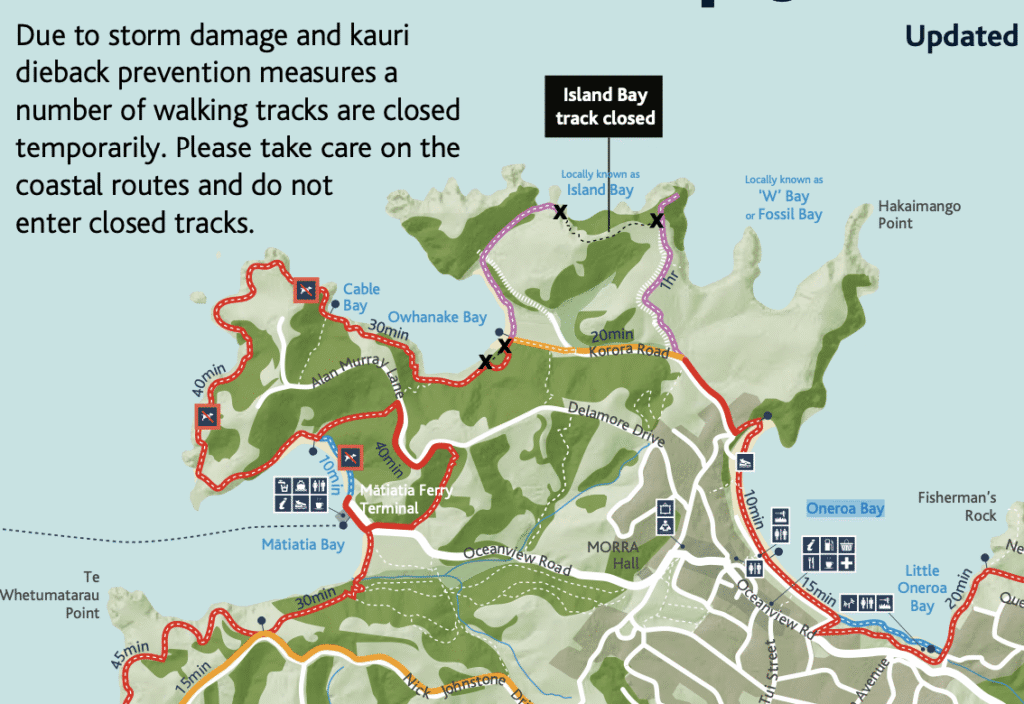
I followed the Te Ara Hura route (red trail) going clockwise from Mātiatia Ferry Terminal. If the Island Bay track is still closed, it might be best to go down Korora Road to link back up to the red trail
Image taken from tourismwaiheke.co.nz
The ferry docks in Mātiatia Bay and as soon as you get off the jetty you will see a sign on the left for the start of your walk. To follow the trail by the beach the tide needs to be out so check the tide times online first. If it’s high tide there is a separate track further up the road on the left and it is sign posted so keep your eyes peeled. Follow this trail until you get to Oneroa Bay, this is a really beautiful beach and good for swimming. There are quite a few cafes nearby, a general store and toilets/ changing rooms. From this beach follow Oceanview Road back to the ferry port.
You can also decide to stay on the island and bring your car over using the Sealink ferry. This ferry docks at a different location so I don’t recommend it if you are planning on not bringing a car. There are quite a few places to stay near Oneroa Bay and further inland.




Days 2 – 4: Coromandel
Auckland to Coromandel -> 2hr 40mins
After exploring Auckland or Waiheke Island its time to jump in the car and head towards Coromandel. You can stay in Coromandel town which is slightly cheaper but most of the attractions are in Hahei. I stayed in Tidewater hostel in the town and it was one of my favourite hostels, mainly because it was the first hostel where the people were really sociable, the hostel itself is okay but for one night it is great.
The first popular attraction is Cathedral Cove which is a really cool natural archway that leads to a limestone stack out in the water, it’s part of a marine reserve so good for snorkelling and scuba diving. I parked my car in the park and ride in town (well signposted) and took the shuttle to the start of the walk, it took me about 15/ 20mins to walk to the Cove. There is a toilet halfway through the walk but no rubbish bins so take all your rubbish back with you. There is a coastal walk you can do too with a nice viewpoint. As the archway is popular on instagram, try and get there early before the crowds arrive.
Hot Water Beach is another popular place, it’s really cool because if you dig a hole in the sand the water is hot due to volcanic activity nearby. You can rent spades from nearby to dig yourself a hole, however, I just walked around the general area and put my feet into the hot water coming out of holes other people had dug. Be careful as if you don’t add cold water from the sea, some of the water is hot enough to burn you. This natural phenomenon is only on a small section of the beach so it gets extremely crowded. You also need to make sure you go at low tide, so check the tide times before you go.
There is also a good beach called New Chums Beach, you have to wade across a river and walk a little while on stones right by the sea so make sure you go at low tide. I didn’t do this and so had to turn around as soon as I got to the beach otherwise I was unsure whether I would get trapped or not. It didn’t help that the sea was a quite rough.
Travel to Mt Maunganui on day 4
Coromandel to Mt Maunganui -> 2hrs 40mins
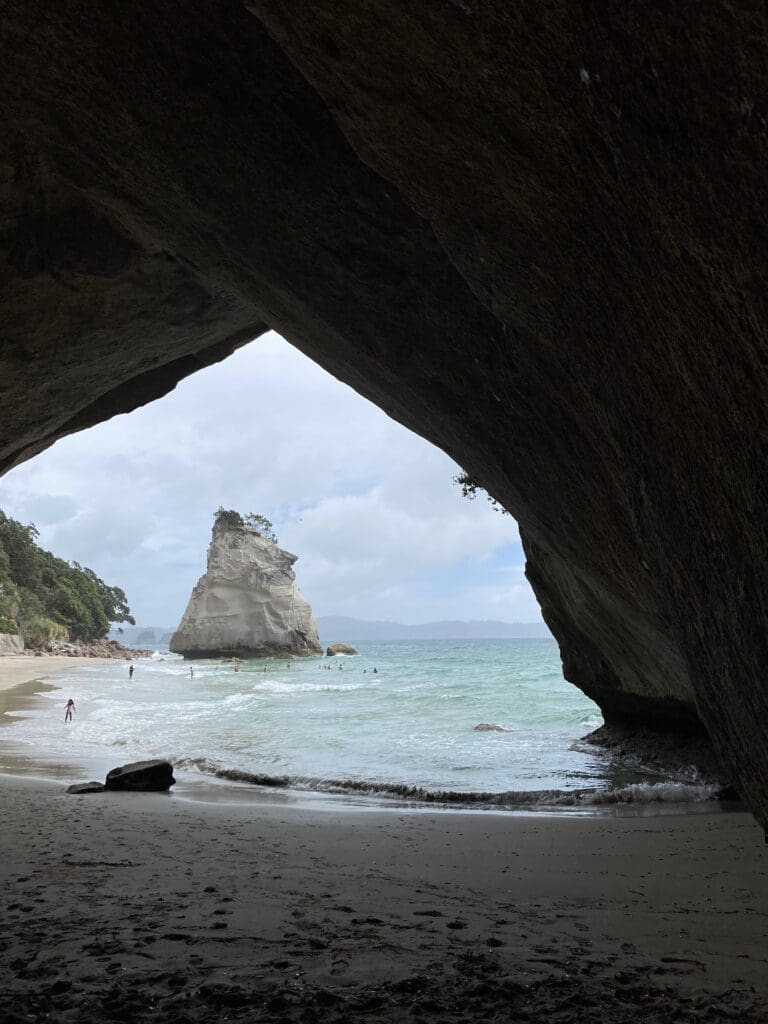


Days 4 – 6: Mt Maunganui
Mt Maunganui to Hobbiton -> 1hr
I used this place as a cheaper alternative to staying in Matamata which is where most people stay before going to Hobbiton. I would say this place is definitely worth a visit even if you plan on staying in Matamata as the view from Mt Maunganui is insane! It is also perfect for sunsets and sunrises.
The day has finally come to see the film set of Hobbiton. Now, I’m not a huge fan of the Lord of the Rings movies but I absolutely loved it here, everything is kept at a high standard and I really felt like I was a giant visiting the homes of Hobbits. Tickets sell out fast so make sure you book in advance. The ginger beer in The Green Dragon™ Inn was so good!
Another option if you don’t want to go to Hobbiton is Omanawa Falls. This was the most incredible place, it was so peaceful and beautiful. It is a hugely significant spiritual place for Māori people so make sure you treat it with respect and for the full peaceful experience for you and fellow adventurers, try to keep your voices down and listen to the wind and the bird calls.
Travel to Rotorua on day 6
Mt Maunganui to Rotorua-> 1hr
You can smell Rotorua before you get there, it has high geothermal activity and so smells strongly of sulphur. I have to admit, I didn’t mind it, it reminded me that I was surrounded by volcanic activity and after a while you don’t notice the smell that much. There is also so much to do in Rotorua, the smell will become background noise.
First of all, on the journey to Rotorua there is a stop that I recommend, Okere Falls. There is a short walk you can do that follows the falls and there are quite a few companies that offer White Water Rafting. While I really wanted to go, my travel insurance did not cover me for Grade 5 rafting so I decided to skip this one out, just as I was travelling alone and didn’t want anything going wrong. It was still a cool stop and if you catch it right, you may also see a couple of rafts going down.




Days 6 – 8: Rotorua
Once in Rotorua, there are so many geothermal activities for you to do, I chose Hell’s Gate as they offer a hot mud spa, walks around geothermal hotspots and you get to do a traditional wood carving included in the price of the walk. I really enjoyed my time here.
The other well known one is Wai-o-Tapo, which has a geyser that goes off at 10am everyday, the only thing I would say about this is that its not ‘naturally’ going off, the workers trigger it by adding a substance that causes it to go off which put me off seeing it. Both of these locations and Te Puia (also a geothermal park) provide Māori experiences, if you wanted to get to know more about their culture, I will talk about the one I did later on.
Another geothermal activity is Waimangu Volcanic Valley, this is slightly further out of the city but I recommend going the extra way, it’s a lot bigger than the other attractions and quieter. I was blown away by the all the volcanic activity in this area and it’s crazy how you can walk right next to them, there was a silica pool which was the most stunning blue colour (weather depending). If you walk to the nature reserve at the end of the trail, you get an amazing lookout point towards Mt Tarawera.
There are a few walks around the Redwood Forest called Whakarewarewa depending on how long you want to walk for, there are multiple routes to follow. It was so cool to see all the Redwoods and it makes you feel so small as the trees are huge.
The other two experiences I did were a Glow worm kayaking experience on Lake Okareka and the Mitai Māori Village. The glow worm kayaking was amazing, we kayaked out on the lake to three different glow worm caves on the lake and sat under the glow worm ‘stars’. They were so cool, the guides were also very knowledgeable about the worms. They even provided hot chocolate and marshmallows while we looked at them. The stars were also incredible on the lake so even if you don’t do the tour, this lake would be a great place for star gazing!
There are so many Māori activities to do in Rotorua and I tried to find the most authentic and having spoken to multiple people I decided to go to the Mitai Māori Village. I really enjoyed the fact that it is run by a local Māori tribe and they teach you the core principles of their culture. You also get to enjoy a buffet which parts are cooked in a Hāngī (a traditional way of cooking food that involves a big hole filled with hot stones, the food is then covered traditionally with flax leaves and the dirt put back over the hole to keep the steam in). As a vegetarian I didn’t try any of the meat cooked this way but the potatoes were the best I’ve ever eaten, and you might be thinking come on Clare they are only potatoes but you’ll have to try them before you judge me. The only negatives I had, were that there were a lot of people at once and so if you weren’t at the front when walking through their village you are just blindly following other tourists which felt a bit odd. It also was very much a performance which is what I tried to avoid as it didn’t feel very authentic. That being said, it was cool to see the family paddling down the river on what would traditionally be their war canoe (Waka), they performed a traditional Haka and taught us about the weapons, toys and customs of the tribes. There are also a few glow worms out and about when they take you on a tour of their village at night.
Travel to Taupō on day 8
Rotorua to Taupō-> 1hr
There are a couple of things to do on your journey from Rotorua to Taupō. If you aren’t geothermaled out by now there is another one called Orate Korako Geothermal Park. This one is a lot quieter than the other parks, however, in my opinion it wasn’t as impressive as some of the other ones. There are two main geysers that may be erupting naturally, they let you know which one is active when you arrive so you aren’t waiting for ages at the inactive one. The main thing that I really enjoyed was the geothermal cave which is one of the only two in the world, the water was super clear and it felt very peaceful.
Another stop is Aratiatia Rapids which is a dam that the operatives release 4 times a week at the same time. There was maintenance going on when I went so the dam was constantly open but normally the river goes from quite empty to extremely powerful in a matter of seconds which I imagine will be awesome to watch.
Lastly, we have Huka Falls which was really beautiful. You can walk to the view point or along the river, this is another spot for adrenaline seekers as there is a company called HukaFalls Jets that takes you out on a jet boat very close to the falls.
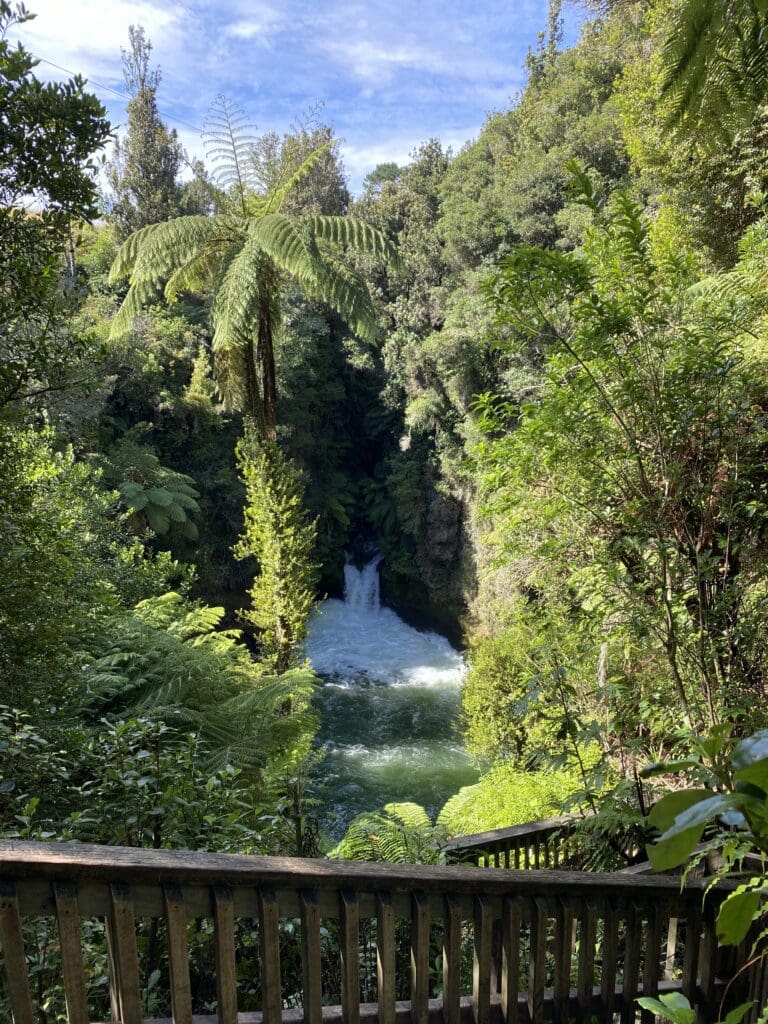
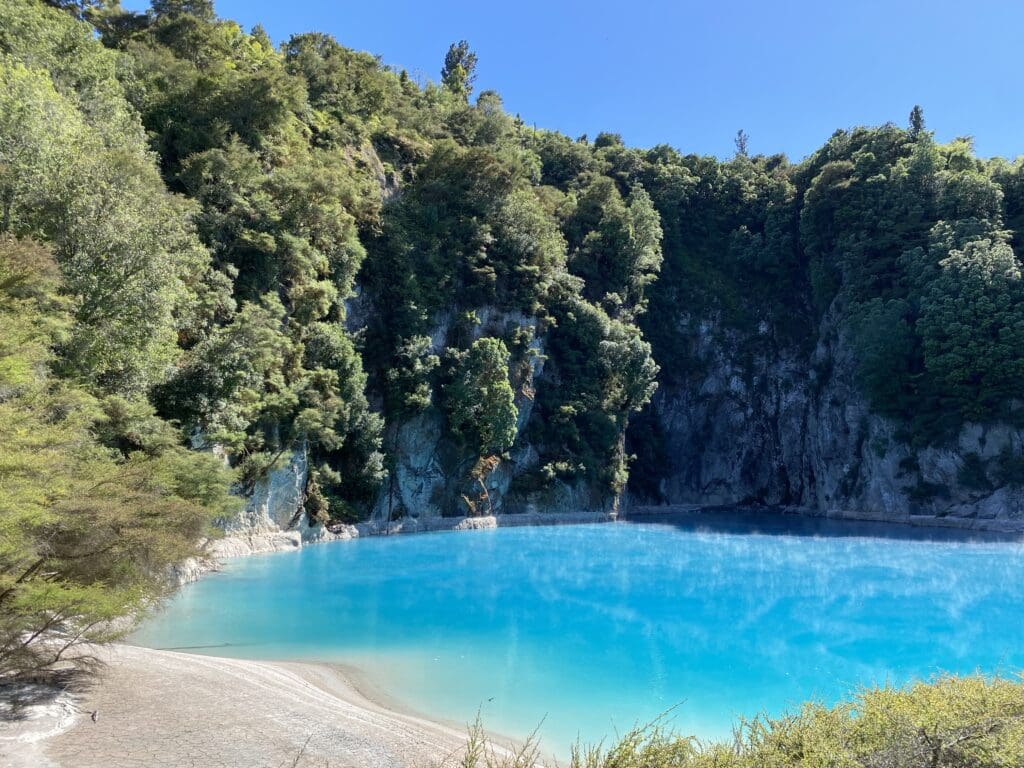




Days 8 – 10: Taupō
(pronounced toe-pour)
Taupō was my favourite place on the North Island, looking back on it now Lake Taupō and the surrounding volcanoes gives you a taste of what the South Island is like. There are loads of attractions to do in Taupō but as I suggest you stay here for 1 full day there is really only one thing I recommend you do on that day and that’s the Tongiario Crossing.
This hike is the one day version of the Tongiario Circuit which usually takes 3-4 days, if you are planning on doing this version you need to make sure that you book the huts/ tent sites well in advance because they sell out super fast! The crossing however, is New Zealand’s most popular one day hike, takes about 8 hours and is absolutely stunning. It is also home to the infamous Mt Doom from Lord of the Rings. Due to unforeseen events I couldn’t do the crossing but hearing from everyone else, it is definitely a must! There are sections of scree (a mass of small loose stones) that make walking downhill a bit scary, however, you can either buy poles to help keep you stable or some people say running down is easiest. Make sure you pack plenty of food and water, bring suncream, sun hat and sunglasses as there is no shade on the trail. The walk is one-way and so most people get a shuttle bus either from their hostel (Finlay Jacks definitely has a shuttle bus) or you can park in the park and ride in the national park and get the shuttle back to your car, be sure to book in advance.
If you don’t feel like walking for a strenuous 8 hours, a good alternative is Tama Lakes which takes between 5-6 hours but the trail is generally flat until you get to the lower lake trail when you have to walk uphill on scree. This walk was incredible and while I am gutted to have missed the Tongiario Crossing I still got to see all the volcanos that I would have walked across! There are two lakes (upper and lower) and a waterfall to walk to, make sure you go to both lakes as the view from the lower lake is unbeatable. On the way back to town, there is a really pretty waterfall called Tawhai Falls (Gollums Pool) that was used in the filming in Lord of the Rings.
Don’t feel like hiking at all or just want to relax after? I’ve got you! Book a boat trip/ kayak to see the Māori rock cavings in the lake. I took the electric boat (Sail Barbary) which was super quiet and lets you soak in the sun in peace, they also offered free tea and coffee and you could even jump in and go for a swim if you wanted. The lake itself is also great for catching rays and swimming. There is also a hot springs nearby which I didn’t go to but a couple of people who completed the walk mentioned that it was great to soak in the hot springs after their walks.
For the adrenaline seekers, Taupō is almost the Queenstown of North Island and offers Bungee Jumps and Skydiving. I did not do a bungee jump here however, I did in Queenstown and I went with the AJ Hackett company and was very happy with their safety and the crew were great at encouraging and being supportive. Therefore, I would suggest using this company for the bungee jump in Taupō.
Travel to New Plymouth in the late morning of day 10
Taupō to New Plymouth -> 3hrs 40mins
On the way to New Plymouth check out Te Waihou Walkway/ Blue Spring and Three Sisters and Elephant Rock. Unfortunately, I didn’t get to see Three Sisters and Elephant Rocks because you need to go at low tide to be able to walk across the estuary to get there. It looks stunning from other peoples pictures so be sure to check out! Te Waihou Walkway/ Blue Spring is a gorgeous river walk along some of the purest water in the world. It was an amazing detour on my journey.
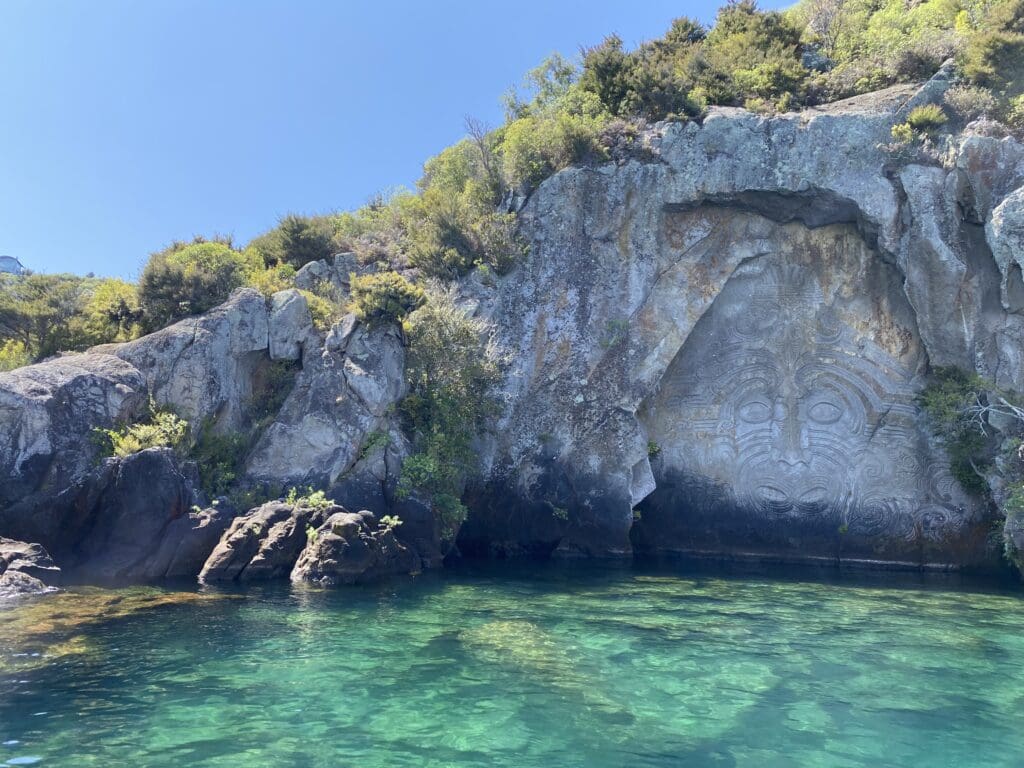
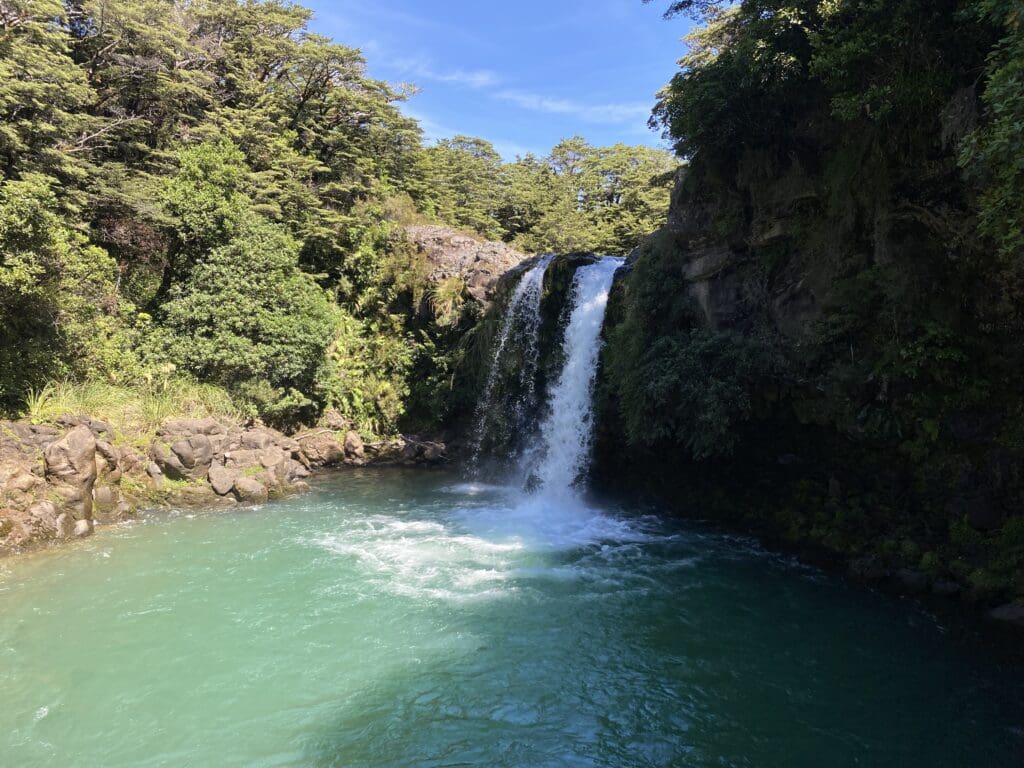







Days 10 – 12: New Plymouth
As you approach New Plymouth you will see why I feel in love with the place. The town is backdropped by a huge volcano (Mt Taranaki) that on a clear day you can see clearly from the New Plymouth Coastal Walkway, there is a bridge that lines up perfectly with the volcano by the boat ramp. There are multiple hikes in Te Papa-Kura-o-Taranaki (formely Egmont National Park) to complete: Around the Mountain (4-5 day loop), Pouākai Circuit which you can do in 2-3 days if you wanted to stay in huts or you can do the 25kms in one day and get a shuttle either back to your car or your hostel.
The one I chose was the Pouākai Tarns walk which consisted of walking on boardwalk steps that feels like they never end, honestly this was the most horrible hike I did in my time in New Zealand but the view from the top is definitely worth it. You step over the brow of a mountain and the most stunning volcano is waiting to greet you! If you carry on walking a little further you get to a small tarn (lake carved out by a glacier millions of years ago) and if weather conditions are right you get an amazing reflection of the volcano in the lake. For the classic Instagram shot, you should aim to leave as early as possible when the wind is lowest and hopefully there aren’t any clouds obscuring you view of the volcano. There is a toilet over halfway on the hike however, it is a long drop so I tend to avoid them unless absolutely necessary, there are nicer toilets in the car park before the hike.
If you have time, on the other side of the national park there are multiple walks you can do to a couple of water falls, I went to Dawson Falls which is about a 10 minutes walk away from the car park and is beautiful.
There are a couple of nice beaches here: Fitzroy and Back beach which are good for swimming and watching the sunset. Back beach faces slightly more westerly and so is better for catching the sunset over the beach. I personally preferred Back beach and there were surfers and a couple of bodyboarders enjoying the waves here.
Travel to Raglan in the late morning of day 12
New Plymouth to Raglan -> 3hrs 40mins
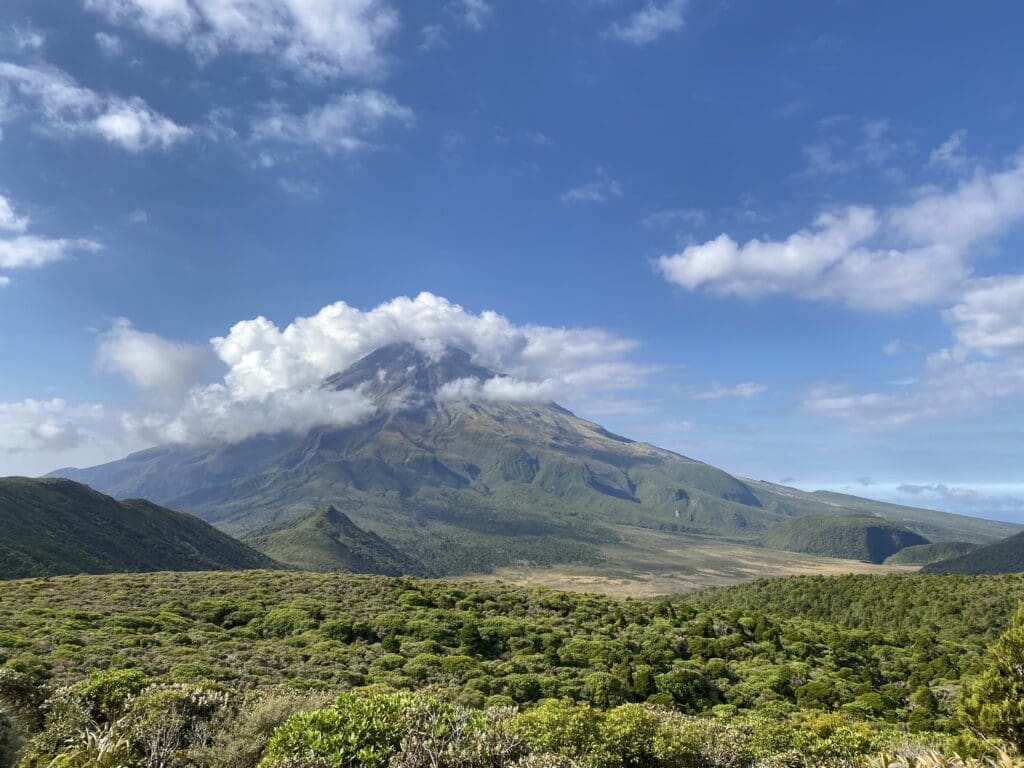
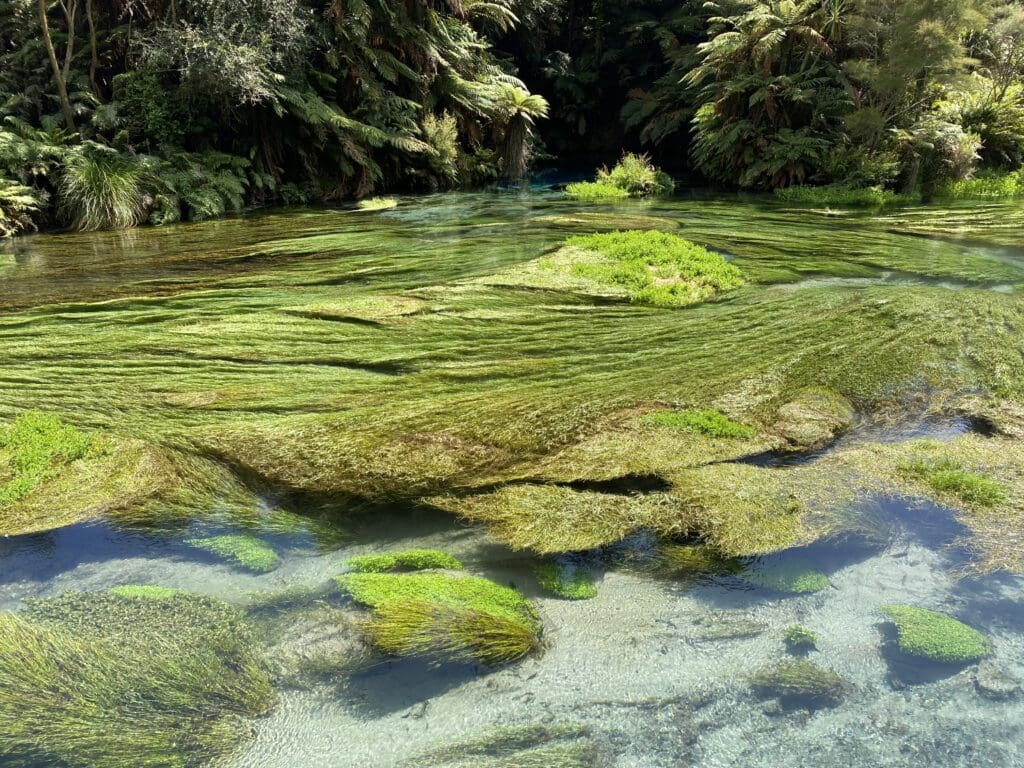





Days 12 – 14: Raglan
Raglan is home to some of the best surfing in New Zealand. Ngarunui Beach is a beautiful volcanic black sand beach which is popular with both experienced and inexperienced surfers alike. You can get a surf lesson, go bodyboarding, swimming or just soaking up the sun. The town itself is a really interesting chilled out surfers town serving great coffee. Ngarunui Beach is also amazing for sunsets.
A short drive away is the stunning Bridal Veil Falls , which is ~30mins of walking through native rainforest following the river to the top of the Falls. There are two viewing platforms at the top of the falls, a view point halfway down and if you carry on following the track you get to another viewing platform with amazing views of the falls and the pool.
Travel back to Auckland on day 14
Raglan to Auckland -> 2hrs 10mins
Finish off looking around Auckland or check out Waiheke Island if you haven’t already. There are some nice beaches around Auckland if you just want to relax before the next part of your journey.
Speaking about your journey, now is a great time to decide whether you are going to visit the South Island or if this is the end of your New Zealand adventure. I highly recommend the South Island, if you liked the North, you will be blown away by the South, I know I was! If you are planning on going down to South Island, instead of flying another option is to travel to Wellington after visiting New Plymouth and take the ferry across to Picton. Whatever your next steps, I hope you have the best time!
North Island. North Island. New Zealand. New Zealand. New Zealand. New Zealand. New Zealand. New Zealand. New Zealand. New Zealand. New Zealand. New Zealand. New Zealand. New Zealand. New Zealand. New Zealand. New Zealand. New Zealand. New Zealand. New Zealand. New Zealand. New Zealand. New Zealand. New Zealand. New Zealand. New Zealand. New Zealand. New Zealand. New Zealand. New Zealand. New Zealand. New Zealand. North Island. North Island. North Island. North Island. North Island. North Island. North Island. North Island. North Island. North Island. North Island. North Island. North Island. North Island. North Island. North Island. North Island. North Island. North Island. North Island. North Island. North Island. North Island. North Island. North Island. North Island. North Island. North Island. North Island. North Island. North Island. North Island. North Island. North Island. North Island. North Island. North Island. North Island. North Island. North Island. North Island. North Island.
